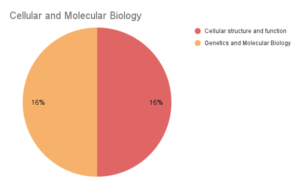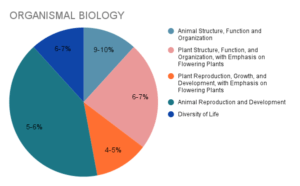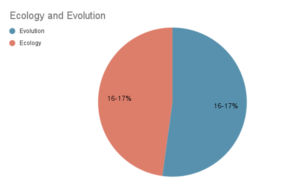Planning to take the GRE Biology test? Then the first thing you should know is the GRE Biology Syllabus. The GRE biology test consists of approximately 188 questions. Most of which are categorized in groups towards the end of the exam and are classified on the basis of diagrams or experimental results, descriptions of field and laboratory situations. The time duration for the test is 2 hours 50 minutes; there are no separately-timed sections.
Now, let us look at the GRE Biology Syllabus in detail. The test is broadly categorized into 3 major areas:
- Cellular and molecular biology
- Organismal biology
- Evolution and ecology
All of the above 3 topics are given equal significance. The total score is reported along with a sub score in each of the sub field areas.
Now let’s take a look at the 3 major areas mentioned above in detail.
Cellular And Molecular Biology
Basics of molecular biology, cellular biology and genetics are addressed here. Some of the other major topics are cellular function and cellular structure which consists of metabolic pathways and their regulation, organelles, cytoskeleton, membrane dynamics, cell surfaces and cell cycle. The mechanisms of antigen-antibody interactions and the cellular basis of immunity, cell pathogen interactions are included as well.
Also, major areas in molecular biology and genetics consist of genomic maintenance and organization, the regulation of gene expression and chromatin and chromosomal structure are also discussed, along with distinctions between eukaryotic and prokaryotic cells. There is also a lot of importance given to experimental methodology.

| Cellular Structure and Function-16 − 17% | Receptor binding, Enzyme activity and regulation |
| Methods –
Microscopy; Immunological; Separation; | |
| Major metabolic pathways and regulation- Degradation and synthesis of macromolecules;
Fermentation,photosynthesis and respiration ; Intracellular messengers and hormonal control | |
| Cell cycle – growth, division and regulation | |
| Organelles: Structure,synthesis, function and targeting –
Mitochondria, plastids and nucleus; Golgi apparatus and secretory vesicles; Endoplasmic reticulum and ribosomes; Peroxisome, Lysosomes and vacuoles | |
| Biological compounds –
Abiotic origin of biological molecules; Macromolecular structure and bonding | |
| Membrane dynamics and cell surfaces –
Electrical potentials and neurotransmitters ; Cell wall and extracellular matrix Mechanisms of cell recognition, cell junctions and plasmodesmata; Transport, endocytosis, and exocytosis; | |
| Biological compounds –
Macromolecular structure and bonding; Abiotic origin of biological molecules | |
| Genetics and Molecular Biology-16 − 17% | Genome maintenance –
DNA repair and mutation DNA replication; |
| Immunobiology –
Cellular basis of immunity; Antibody diversity and synthesis Antigen-antibody interactions | |
| Gene expression and regulation: Effects –
Control of normal development; Regulation of gene expression by RNAi (eg.siRNA); Whole genome expression(eg. microarrays); Epigenetics Cancer and oncogenes | |
| Recombinant DNA methodology-
Restriction endonucleases; Hybridization and blotting; Polymerase chain reaction; DNA cloning, analysis, and sequencing ; Restriction fragment length polymorphisms | |
| Genetic foundations –
Pedigree analysis ; Prokaryotic genetics (transduction, conjugation and transformation); Mendelian inheritance; Genetic mapping | |
| Genome sequence organization-
Transposable elements Introns and exons; Repetitive and single-copy DNA | |
| Gene expression and regulation in eukaryotes and prokaryotes: Mechanisms
Promoters and enhancers; Transcription factors; The operon; Protein synthesis and RNA; Modifications and processing of both protein and RNA | |
| Chromatin and chromosomes –
Nucleosomes Chromosomal aberrations Karyotypes Polytene chromosomes | |
Organismal Biology
Around 33 − 34% questions come from this section. Physiology, behavior, structure, and development of animals and plants are part of the syllabus. The topics covered comprise gas exchange, reproduction in heterotrophic and autotrophic organisms, nutrient processing and procurement, internal transport, effectors and control mechanisms and regulation of fluids.
Also, examples of developmental phenomena could be from a wide range — from fertilization through morphogenesis to differentiation. Perceptions and responses to environmental stimuli are evaluated as they belong to both animals and plants. Major features and phylogenetic relationships of selected groups from the various kingdoms are included as well.

| Plant Structure, Function and Organization with more Emphasis on Flowering Plants-6 − 7% | Reproductive structures |
| Plant energetics (like respiration and photosynthesis) | |
| Mineral nutrition | |
| Tissues, tissue systems and organs | |
| Phloem transport and storage | |
| Water transport including absorption and transpiration |
| Animal Reproduction and Development-5 − 6% | Early development (like gastrulation, cleavage and polarity) |
| External control mechanisms (like photoperiod) | |
| Developmental processes (like induction, morphogenesis, differentiation, metamorphosis and determination) | |
| Gametogenesis, fertilization and meiosis | |
| Reproductive structures |
| Animal Structure, Function and Organization-9 − 10% | Movement and support – Movement systems (muscular, ciliary and flagellar) Support systems (hydrostatic,internal and external) |
| Internal transport and exchange – Circulatory, gastrovascular and digestive systems | |
| Exchange with environment – Nutrient, salt, and water exchange; Gas exchange;Energy | |
| Metabolic rates (Body size ,activity and temperature) | |
| Integration and control mechanisms Nervous and endocrine systems | |
| Behavior (communication, orientation, learning and instinct) |
| Plant Reproduction, Growth and Development with more Emphasis on Flowering Plants 4 − 5% – | Fertilization and gametogenesis |
| Sporogenesis and meiosis | |
| Control mechanisms (like hormones, photoperiod and tropisms) | |
| Reproductive structures | |
| Seed development and embryogeny | |
| Growth, differentiation, morphogenesis and meristems. |
| Diversity of Life 6 − 7% | Archaea – Morphology, physiology and identification |
| Protozoa, autotrophic Protista and other heterotrophic Protista (Oomycota and slime molds) | |
| Bacteria- Morphology, physiology, pathology and identification | |
| Fungi – Lichens; Generalized Life cycles Distinctive features of major phyla (sexual, asexual reproduction and vegetative); Importance (eg- decomposition,antibiotics, pathogenicity, biodegradation); | |
| Lichens – Plantae with emphasis on major phyla- Alternation of generations; Major distinguishing characteristics; Phylogenetic relationships | |
| Major characteristics of phyla (vegetative, asexual and sexual reproduction) | |
| Animalia with emphasis on major phyla – Major distinguishing characteristics; Phylogenetic relationships | |
| Protista |
Ecology and Evolution
Evolutionary and ecological topics are given equal weightage in the exam. Although principles are given more importance, a few of the questions are also applicable to current environmental problems. Additionally, ecological questions range from physiological adaptations to the functioning of ecosystems.
Moreover, questions in evolution can be from genetic foundations through evolutionary processes and the consequences owing to it. Evolution is considered at the population, individual , molecular and higher levels. Principles of Genetics, evolution and ecology are closely linked in many questions. Few questions might also require the use of quantitative skills which consist of the interpretation of simple mathematical models.

Evolution-16 − 17%
| Genetic variability | Origins (Linkage, mutations, chromosomal alterations and recombination) Levels (like heritability and polymorphism) |
| Hardy-Weinberg equilibrium | |
| Spatial patterns (like ecotypes and clines) |
| Evolutionary processes | Genetic drift and gene flow; |
| Natural selection; Levels of selection (like group and individual) | |
| Evolutionary consequences: Fitness and adaptation; Extinction, divergence, and convergence, Speciation, Phylogeny and Systematics | |
| History of life: Origin of eukaryotic and prokaryotic cells Paleoecology and paleontology Fossil record |
Ecology-16 − 17%
| Environment/organism interaction Biogeographic patterns |
| Adaptations to environment |
| Change and succession Ecosystems Productivity and energy flow |
| Temporal patterns Behavioral Ecology Habitat selection; |
| Community structure and diversity; |
| Demography and life history strategies Communities Interspecific relationships |
| Social systems |
| Chemical cycling |
| Mating systems |
| Resource acquisition Population structure and function Population dynamics/regulation |
We hope this GRE Biology Syllabus information helped. Moreover, feel free to download the GRE Biology Syllabus pdf from the ETS website, so that you can find more information in details.
IMPORTANT UPDATE: The GRE BIOLOGY TEST HAS BEEN DISCONTINUED from the month of April or May 2021, hence, make sure you find out these details from the official website or concerned person before you proceed with your preparation.










Talk to an expert?